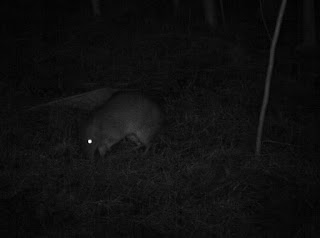Long-nosed Bandicoot Recovery
The Long-nosed Bandicoot(Perameles nasuta) pictured here was recently killed by a vehicle on the Whittlesea-Yea Road and is unfortunately one of five known road-kill bandicoots in the past few months, mostly in the Stony Creek area at Kinglake West.
 |
| Long-nosed bandicoot road-kill at Kinglake West |
There is conjecture about the reasons for this spate of road deaths. One theory, looking on the positive side, is that, although disturbing to see these lovely animals being killed, it may indicate a large increase in the local bandicoot population following the bushfires in the area in 2009.
This may be as a result of the past two relatively wet years providing soft earth to dig in and a flush of insects and fungi, which constitute a large part of the bandicoot’s diet.
Long-nosed bandicoots forage in leaf litter and often dig characteristic conical holes to locate invertebrates and underground-fungi. The bandicoot also eats lush plant material and the prolific regrowth of vegetation after the fires provides both food and cover from predators.
Long-nosed Bandicoots are most active during the night. It is more likely that you will see evidence of the animal’s conical diggings on your property before you see a bandicoot.
 |
| Long-nosed Bandicoot near King Parrot Creek |
 |
| Long-nosed Bandicoot near King Parrot Creek |
At one site near the King Parrot Creek we have been able to capture dozens of photos of living Long-nosed Bandicoots by using movement activated cameras.





[…] seem to have increased since the 2009 fires along the Stony Creek at Kinglake West, along the King Parrot Creek down to Hazeldene and at Toolangi.The thick regrowth of native vegetation has probably favoured the […]
[…] found a road-kill Long-nosed Bandicoot on the adjacent roadside and I found what appeared to be Long-nosed Bandicoot diggings around the wetland. Unfortunately we weren’t able to get any photo’s of […]